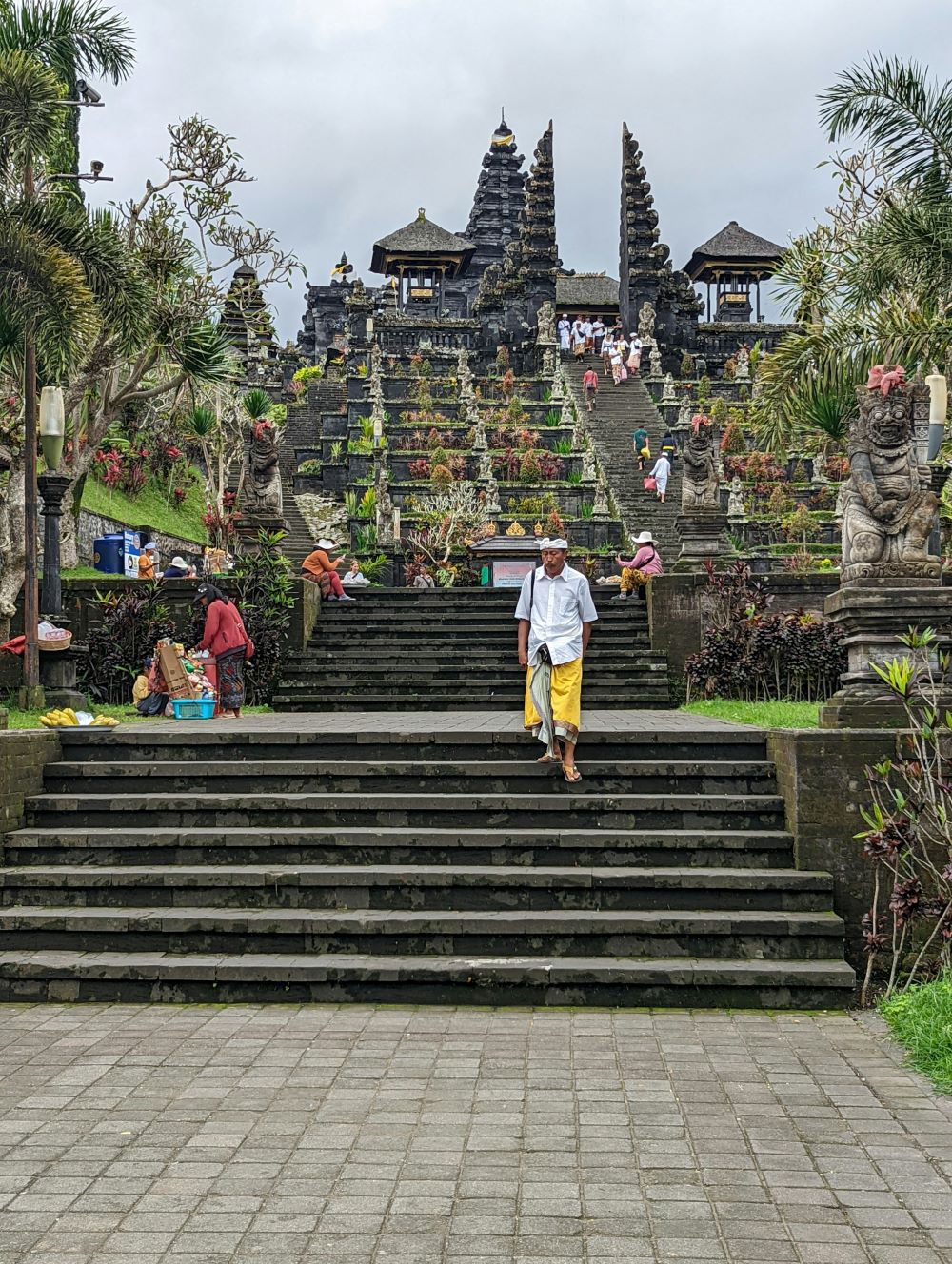Explore the sacred Besakih Temple, Bali's largest. Plan your trip today!
Located on the slopes of Mount Agung, Bali’s highest volcano, Besakih Temple is the grandest, most significant, and most spiritually profound temple complex on the island. Also known as the Mother Temple of Bali. Besakih isn’t just a temple; it’s an entire complex, a spiritual village.
About Besakih Temple
Originated in the 8th century, it was established by a Javanese priest named Rsi Markandeya and over all these years, the temple has evolved into the huge complex as it is today.
Considered one of the best temples in Bali, Besakih Temple is not just one temple – it’s an extensive religious complex comprising 23 separate but related temples with the largest and most significant being Pura Penataran Agung, that stands tall in the heart of all. The temple is built on six levels, terraced up the slope. The entrance is marked by a candi bentar (split gateway), and beyond it, the Kori Agung is the gateway to the second courtyard.
The Temple’s whole structure follows the Balinese Hindu concept of Tri Hita Karana, that aims to bring harmony between God, humans, and nature. Each temple within the complex serves different purpose, and the entire site is dedicated to the Hindu trinity: Brahma (the creator), Vishnu (the preserver), and Shiva (the destroyer).
Besakih temple being an active place of worship, you can casually stroll around, like in other Balinese temples. The temple regularly hosts grand ceremonies, and if you happen to visit during one of these, you will likely witness a crowd of beautifully dressed Balinese Hindus offering prayers, incense, and colorful offerings.
Location of Besakih Temple
Besakih Temple is located in East Bali in the village of Besakih in Karangasem. The entire temple complex sits at approximately 1,000 meters (3,280 feet) above sea level and offers breathtaking views of lush green landscapes, traditional rice terraces, and a rather majestic peek at Mount Agung (if the weather allows you to). About a 2-hour drive from Ubud and about the same from Seminyak, making it perfect trip for taking a break from the beach clubs and spending some time exploring this tranquil side of the island.
Besakih Temple Entrance Fees
Though the Mother Temple offers a valuable experience, but it is not free. The current entrance fee to Besakih Temple is IDR 150,000 per person (about USD $9.10 / AUD $15). Payments can be made in cash or by card on location.
The entrance fee comes with a mandatory local guide that help you navigate the temple complex, sarong rental, which is also mandatory and considered a sign of respect from visitors. The staff at the rental desk will help you put on the sarong. Your entrance ticket also includes a one-way shuttle bus ride that will take you to the top near the main entrance. You can choose to walk back down (10-15 minutes) or pay another IDR 20,000 per person to get the return shuttle.
It is generally one of the most expensive temple entrance tickets in Bali, but when you consider what you get for the fee, it’s actually a fair deal – especially the fact that you’re assigned an on-site guide who knows the temple’s layout and history.
What to expect
A tour guide: Since your entrance fee includes a guide, you’ll be exploring the temple complex alongside an on-site guide who speaks English and can explain the history of each temple and what they signify. He can also help with taking photos.
Long walks and stairs: The complex is massive. Be prepared to do some walking and get a leg exercise. However, the view from the top is worth it.
A majestic atmosphere: The temple lies against the stunning backdrop of Mount Agung, so be ready for some incredible views and a sense of tranquillity.
Religious ceremonies: You can also expect to witness traditional Balinese ceremonies with locals bringing offerings and priests performing prayers.
Local vendors: Expect to encounter very friendly local vendors offering to sell you souvenirs and traditional crafts. If you’re not interested, a polite but firm “no, thank you” does the trick. If you do plan on shopping, dust off your negotiation skills.
How to get to Besakih Temple?
Book a Private Car & Driver (for East Bali)
Since East Bali lies at a distant from most major destinations in Bali, the best way to visit Besakih is to book a private car and driver. You’ll be in the comfort of your own air-conditioned SUV without having to stress about getting soaked in the rain, navigating traffic, or getting lost with Google Maps. Parking fee for car is IDR 10,000.
Rent a scooter from Bikago
Rent a scooter in Bali and riding it all the way to Besakih Temple for a wonderful experience. Travel light to avoid back pain, and pack a raincoat or rain poncho in case you get caught in the rain on the way. Also, once you start entering Karangasem area, the roads are winding and sometimes steep, so ride carefully. Parking fee for scooter is IDR 5,000.
Best time to visit Besakih
When visiting Bali’s Mother Temple, timing is everything. To avoid the midday heat and the crowds, early mornings or late afternoons are ideal. If you’re visiting during Galungan and Kuningan, even better – this is when the temple is at its most vibrant, filled with ceremonies, offerings, and traditional music. Regardless of the time of the year, the crowds start to form around 10:00 am. Operating hours are 7:00 am – 6:00 pm, daily.
Dry Season (April to October): This is the prime time to visit – Bali’s nature is less moody with bright sunshine and clear skies, allowing you to roam the temple grounds freely without worrying about getting soaked.
Wet Season (November to March): Less ideal but there are perks to visiting during rainy season. The surrounding landscapes turn into a lush, green paradise, and the Mother Temple takes on a misty and mystical vibe. Pack an extra umbrella or raincoat just in case.
Tips for Visiting Besakih Temple
Getting there: Besakih is about 60km away from Denpasar, so it takes minimum of 90 minutes’ drive by car from most major destinations in Bali. It is best to Book a private car and driver for a Besakih Temple Tour.
Best time to visit: Try arriving in early mornings or late afternoon as the crowds will be less and lighting is better for photos. The rush normally begins around 10:00 am, you can have the entire place to yourself at around 7:00 – 8:00 am.
Wear comfortable shoes: Since the temple complex is enormous, and a decent amount of uphill walking is required. So, wear comfortable shoes that won’t hurt after a few flights of stairs.
Dress code: Dress modestly, respecting for the temple’s sacred nature. Both men and women should wear a sarong and sash which is included in your entrance fee. You can also buy from one of the many vendors at the temple.
Politely refuse: There will be women trying to sell you offerings at the temple gates claiming they’re mandatory, which is a complete lie as there is no need of buying offerings to enter the temple complex. This is only for those who are attending the temple to worship. The offerings are extremely overpriced, do not buy it, just refuse politely.
Respect local customs: While exploring the temple complex, remember to be mindful of ongoing religious ceremonies. Visitors should refrain from entering areas reserved for worshippers.
Bring cash: Always carry cash as you’ll need it to pay for your parking fees, entrance fees and in case you need to grab a bottle of water or a souvenir.
Ask questions: Your tour guide will be included in your entrance fee and will guide you all the way to the top and back down. Feel free to ask loads of questions to make the most out of your experience.
Keep an open mind: Take your time and soak in the spiritual atmosphere. Besakih is more than just a tourist attraction – it’s the heart of Balinese Hinduism and a place of deep cultural significance.
To know more about travel and tourism and want us to plan your best travel experience with us call or WhatsApp at +91-9733533000 or you can visit https://www.marinetoalpine.com


